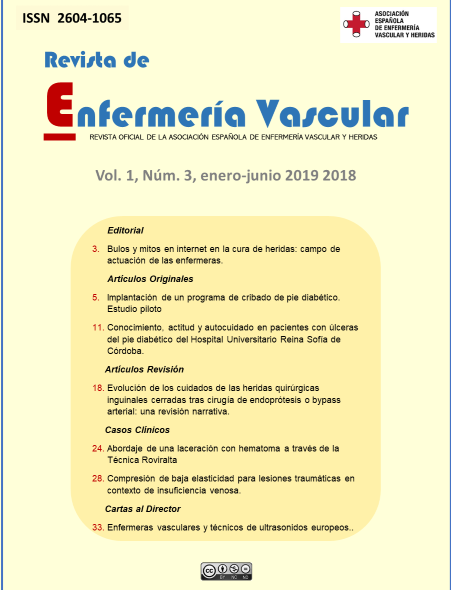Abstract
In Segovia’s health area there isn’t any documented experience in the implementation of foot screening programs in the diabetic patient. The objective of this study was to pilot a program that would allow foot screening in this type of patients, classifying it according to the risk detected to implement individualized interventions. A pilot study was carried out in two health centers belonging to the Health Care Management of Segovia from March 2017 to June 2018. 50 participants were followed for three months to see if after screening treatment and education, ulcers were still present.
The variables included in the screening program were selected based on the recommendations consulted, developing an "ad hoc" questionnaire for its registration and subsequent transfer to the computerized medical history ME-DORA CYL 2.4. Screening programs allow you to anticipate the complications that arise from chronic processes or diseases. The aim of the present work is to reduce the prevalence of ulcers in patients with diabetes mellitus.
References
Apelqvist J LJ. What is the most effective way to reduce incidence of amputation in the diabetic foot? Diabetes Metab Res Rev. 2000;16(Suppl 1):S75-83.
Bakker K, Apelqvist J, Lipsky BA, Van Netten JJ, Schaper NC. The 2015 IWGDF guidance documents on prevention and management of foot problems in diabetes: Development of an evidence-based global consensus. Diabetes Metab Res Rev. 2016;32:2-6.
Bakker K, Schaper NC, Apelqvist J. Practical guidelines on the management and prevention of the diabetic foot 2011. Diabetes Metab Res Rev [Internet]. 2012; 28 Suppl 1(September 2011):225-31. Disponible en: http://www.ncbi.nlm.nih.gov/pubmed/22271742%5Cnhttp://www.ncbi.nlm.nih.gov/pubmed/22271736.
Boulton AJ, Vileikyte L, Ragnarson-Tennvall G, Apelqvist J. The global burden of diabetic foot disease. Lancet. 2005;366(9498):1719-24.
Bus SA, van Netten JJ, Lavery LA, Monteiro-Soares M, Rasmussen A, Jubiz Y, et al. IWGDF guidance on the prevention of foot ulcers in at-risk patients with diabetes. Diabetes Metab Res Rev. 2016;32:16-24.
Duarte Cubelo A, Escuedero Socrro M, Ibrahim Achi Z, Martinez Alberto CE;, Moreno Valenín GJ, Perdomo Pérez E, Pérez Rodríguez MF, Tristancho Ajamil R. Guía de actuación Pie diabético en Canarias [Internet]. 2017. Disponible en: http://www3.gobiernodecanarias.org/sanidad/scs/content/81a29c98-d053-11e7-836b-953b40afb30b/GuiaPieDiabetico.pdf.
Cardona CC, Zaldivar IE, Álvarez I, Rodríguez A. Dra. Lissette Vinent Despaigne,. MEDISAN [Internet]. 2018;21(5):518-30. Disponible en: http://www.medigraphic.com/pdfs/medisan/mds-2018/mds185i.pdf.
Ezkurra P, Alemán JJ, Álvarez F, Artola S, Ávila L, Barrot J. Guía de actualización en Diabetes Mellitus tipo 2 [Internet]. Fundación RedGDPS. 2016. 1-256 p. Disponible en: http://www.redgdps.org/gestor/upload/GUIA2016/Guia_Actualizacion_2016v2.pdf.
Jiménez S, Rubio JA, Álvarez J, Lázaro-Martínez JL. Analysis of recurrent ulcerations at a multidisciplinary diabetic Foot unit after implementation of a comprehensive Foot care program. Endocrinol Diabetes y Nutr [Internet]. 2018;(xx):1-10. Disponible en: https://doi.org/10.1016/j.endinu.2018.03.012.
Martínez Quiroga, M.F. Barranco San Martín, A.I. Marcos Peñaranda, M.G. Zorita-Viota Sánchez, L. Blanco Arias, M.E. González Fernández MA. Subproceso asistencial integrado de atención al pie de las personas con diabetes [Internet]. 2016. p. 1-54. Disponible en: https://www.saludcastillayleon.es/profesionales/es/procesos.
Miller JD, Carter E, Shih J, Giovinco NA, Boulton AJM, Mills JL, et al. How to do a 3-minute diabetic foot exam. J Fam Pract [Internet]. 2014;63(11):646-56. Disponible en: http://search.ebscohost.com/login.aspx?direct=true&db=a9h&AN=99574005&site=ehost-live&scope=site.
Ministerio de Sanidad C y BS. Indicadores Clave del Sistema Nacional de Salud. [Internet]. 2017. Disponible en: http://inclasns.msssi.es/main.html.
Monteiro-Soares, Matilde & Boyko, Edward & Ribeiro, J & Ribeiro, I & Dinis-Ribeiro M. Predictive factors for diabetic foot ulceration: A systematic review. Diabetes Metab Res Rev. 2012; 28:574-600.
Navarro-Pérez J. Franch-Nadal J. Artola-Menéndez S. Díez-EspinoJ. Garcia-Soidán J. La historia clínica electrónica y los registros sobre diabetes en España. Av en Diabetol [Internet]. 2011;27(4):128-36. Disponible en: http://www.elsevier.es/es-revista-avances-diabetologia-326-articulo-la-historia-clinica-electronica-los-S1134323011000020.
Netten JJ Van, Lazzarini PA, Armstrong DG, Bus SA, Fitridge R, Harding K, et al. Diabetic Foot Australia guideline on footwear for people with diabetes. J Foot Ankle Res [Internet]. 2018; 11(2):1-14. Disponible en: https://jfootankleres.biomedcentral.com/articles/10.1186/s13047-017-0244-z.
NICE. Diabetic foot problems:prevention and management. NICE Guidel [Internet]. 2015; Disponible en: https://www.nice.org.uk/guidance/ng19/resources/diabetic-foot-problems-prevention-and-management-1837279828933.
Ocampo-Barrio P, Landeros-González D MRL. Frecuencia de depresión en pacientes con y sin pie diabético. Semer - Med Fam. 2010;36(49):1-6.
Perera AE, Yudit ID, García G, Manuel II. Identificación de las deformidades podálicas en personas con diabetes mellitus , una estrategia para prevenir amputaciones Identification of foot deformities in diabetes mellitus patients , a strategy to prevent amputation. 2013;24(2):297-313.
Prompers L, Schaper N, Apelqvist J, Edmonds M, Jude E, Mauricio D, et al. Prediction of outcome in individuals with diabetic foot ulcers: Focus on the differences between individuals with and without peripheral arterial disease. The EURODIALE Study. Diabetologia. 2008;51(5):747-55.
Shahbazian H, Yazdanpanah L, Latifi SM. Risk assessment of patients with diabetes for foot ulcers according to risk classification consensus of international working group on diabetic foot (IWGDF). Pakistan J Med Sci. 2013;29(3).
Shaw, J.E BJ. The pathogenesis of diabetic foot problems. Diabetes. 1998;46(Suplemento 2):S58-61.
Stockl K, Vanderplas A, Tafesse E CE. Costs of Lower-Extremity Ulcers Among Patients With Diabetes. Diabetes Care. 2004;27(9):2129-34.
Robbins JM, Strauss G, Aron D, Long J, Kuba J, Kaplan Y. Mortality Rates and Diabetic Foot Ulcers. J Am Podiatr Med Assoc [Internet]. 2008;98(6):489-93. Disponible en: http://www.japmaonline.org/doi/abs/10.7547/0980489.
Roldán A, Ibáñez P, Alba C, Roviralta S, Casajús M, Gutiérrez P. Consenso sobre úlceras vasculares y pie diabético de la Asociación Española de Enfermeria Vascular y Heridas (AEEVH). Aeevh [Internet]. 2017;140. Disponible en: https://www.aeev.net/pdf/Guia-de-Practica-Clinica-web.pdf.

This work is licensed under a Creative Commons Attribution-NonCommercial-NoDerivatives 4.0 International License.

